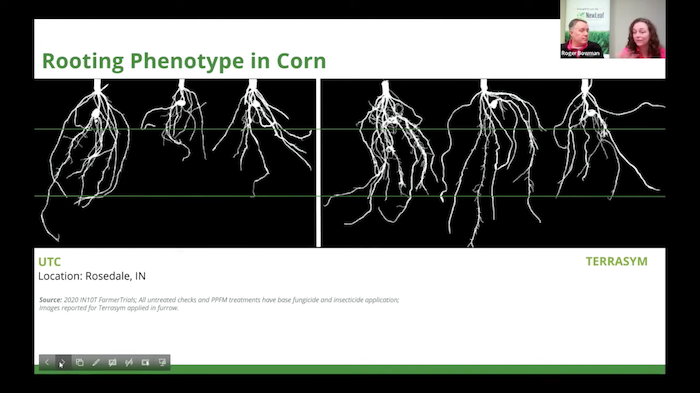No-tillers can harness the power of pink microbes to improve their yields with NewLeaf Symbiotics’ Terrasym products for corn and soybeans. The company reports its Terrasym microbial products increases soybean yields by 2 bushels per acre and corn yields by 4.5 bushels per acre on average.
NewLeaf uses pink-pigmented facultative methylotrophs (PPFMs), one of the few microbe families to have no known strains that impact plants negatively. These pink bacteria occur naturally, colonize all crops and work with no energy cost to the plant.
“They can metabolize methanol as their sole carbon source, which is unique across all bacteria,” says Allison Jack, a product technical director at NewLeaf who’s been researching biologicals for 20 years. “They're not competing for carbon with other microbes in the plant microbiome. This carbon that the PPFMs can use has been used by the plant for their own metabolism. The PPFMs are using a waste product.”
PPFMs colonize plant roots as they emerge, and then the bacteria will move up into the plant foliage as it grows.
“What that is doing is allowing nutrient uptake to be more efficient for the plant,” says Roger Bowman, agronomy lead at NewLeaf. “They're pulling out more nitrogen, phosphorus and potassium. But they're also pulling in micronutrients, which then stimulates the plant, turning on gene expression or improving plant vigor. Overall, we want a healthier plant at early stages to set high yield potential.”
How Do PPFMs Improve Yield?
Bowman says PPFMs continue to keep growing and bringing benefits to the plant, even when the plant shuts down during the season. These bacteria secrete beneficial molecules that can bind and transport micronutrients, and they improve nutrient uptake by populating plant roots, which promotes more root tips and overall root mass.
According to NewLeaf’s farmer trials, corn plants responded to Terrasym 80% of the time, while soybeans responded 75% of the time. The trials show Terrasym produced an average 2 bushel per acre increase in soybeans and 4.5 bushel per acre increase in corn. Total soybean root area increased by almost 10%, while corn total root area was up by more than 6%. Roots also grew deeper, and leaves on both crops had higher leaf tissue iron concentrations.
Beck’s Practical Farm Research also evaluated Terrasym 450 for corn from 2020-22, and this research found the product resulted in a 3.8 bushel per acre increase for corn and a $12.45 net return per acre. The Terrasym 401 product for soybeans showed a $12.71 return on investment in Beck’s 3-year study evaluating products that help with iron deficiency chlorosis.
How to Apply Terrasym
NewLeaf’s PPFM product Terrasym is applied in the planter box, which avoids the pre-slurry wetting process that can lead to cells dying off and achieves more than 10,000 live cells per seed. The preferred method is a dry powder application in the planter box to avoid compatibility issues.
Jack says the active ingredients in fungicides and insecticides have no negative impact on bacteria, but if it’s a liquid-formulated product in a jug, it will have a biocide in it to keep it shelf stable. In this scenario, a farmer can’t tank mix Terrasym with the liquid products, but they can co-apply or sequentially apply it.
Terrasym is stable for 9 months at the warehouse temperature on the label, but it can last more than 2 years at 40 degrees F refrigeration. It can be added to the planter box 3 months before planting, and it works effectively with a center-fill planter. In fact, Jack says most of the 2021 trials were done using a center-fill planter. There are some best practices for adding Terrasym, but as long as it’s applied according to the instructions for the matching seed lubricant, it will work.
No-tillers can buy Terrasym products through NewLeaf’s distributors: Low Mu Tech and Meristem and AMVAC. All three partners have instructions for proper application.
Related Content
How Pink Microbes Boost Your Crop Performance with Terrasym [Webinar]
[Video] NewLeaf Symbiotics Grows Ag Presence with New Terrasym Seed Treatments
NewLeaf and Meristem Join Forces to Bring Innovative Biologicals to More Acres







